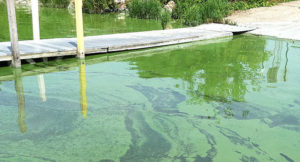Wednesday, July 25, 2018
Lake Erie, (photographed above in June 2018) the 2nd smallest of the great lakes which borders Michigan, Ohio, Pennsylvania, and New York is facing another summer of serious algal blooms. The algae is capable of shutting down water systems, closing beaches, and disrupting the tourist economy. Although this summer’s bloom isn’t predicted to be as serious as the record blooms in 2011 and 2015, it is no less toxic.
Scientists have determined that the record-breaking algal bloom in 2011 was caused by a combination of contemporary agricultural practices and anomalous weather events. It has become more common for farmers to prepare their fields in the fall to be ready for the next planting season, which means that additional layers of fertilizer are applied at the end of the harvest season.
When applied at the end of the season, fertilizer is scattered on the surface of the soil instead of being injected into the soil like in the Springtime. When only scattered on the surface, the fertilizer is more easily washed away during the rainy seasons. The amount of fertilizer on the farmer’s soil is not the problem. The problem is when excess fertilizer reaches wetlands and waterways.
2011 also experienced unique and unfortunate weather events, which were ideal for the growth of algae. Heavy rainfall increased nutrient flow into the water in the springtime, and then lack of wind during the summer caused the lake’s surface to be uncommonly still, leading to more algae growth.

Lake Erie algal bloom scum. Credit NOAA GLERL
The 2015 bloom was not as large as in 2011, but the algae was more toxic. It was so dangerous, in fact, that a man was hospitalized after being exposed to the water for a single day fishing. The water was contaminated with microcystin, a liver toxin. The high concentration of this toxic algae caused the city of Toledo, Ohio, to tell its residents that they could not drink the tap water for three days.
In 2015, under pressure from people across the Great Lakes region, the Governors of Ohio and Michigan joined with the Premier of Ontario to commit to reducing the amount of runoff pollution, specifically phosphorus, flowing into western Lake Erie by 40 percent by 2025. EPA Satellites above and robots under Lake Erie’s surface have been utilized as a part of a network of scientific tools trying to keep algal toxins out of drinking water supplies. This technology is able to detect blooms before they are even visible from the shore.
Farmers, who are responsible for a large share of the nutrient pollution entering Lake Erie, feel they are being unfairly targeted by government regulation. On top of that, they are receiving only 1% of the $3 billion dollars the state is investing to improve Lake Erie’s water quality. The EPA states that one of the most impactful practices farmers can do is reducing their overall fertilizer usage and planting grasses and cover crops to reduce erosion and absorb more excess nutrients from the soil. This tension between farmers and environmental regulators has severely hampered water cleanup efforts.
Farmers believe they would be able to reduce their fertilizer usage if they received more money from the state to make up for their lost crops because they would not do a second planting. By pledging money to farmers, less funds would be needed for physical cleanup efforts. The EPA would decrease nutrient pollution at its source and help restore Lake Erie’s water quality.
The Ocean River Institute provides opportunities to make a difference and go the distance for savvy stewardship of a greener and bluer planet Earth. www.oceanriver.org